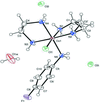issue contents
March 2019 issue

Cover illustration: In Chloridobis(ethane-1,2-diamine)(4-fluoroaniline)cobalt(III) dichloride monohydrate, the complex cation and the two counter-anions are linked via N-H Cl, O-H
Cl, O-H Cl and C-H
Cl and C-H Cl hydrogen bonds, generating rings with R42(8), R21(6), R42(10) and R22(6) graph-set motifs. See: SubbiahPandi, AaminaNaaz, Mahalakshmi & Anbalagan [IUCrData (2019). 4, x190327].
Cl hydrogen bonds, generating rings with R42(8), R21(6), R42(10) and R22(6) graph-set motifs. See: SubbiahPandi, AaminaNaaz, Mahalakshmi & Anbalagan [IUCrData (2019). 4, x190327].
metal-organic compounds
Download citation


Download citation


Open  access
access
 access
accessThe PtII atom in the title compound exhibits a distorted square-planar CClN2 coordination environment.
CCDC reference: 1899620
Download citation


Download citation


Open  access
access
 access
accessThe complex cation and the two counter-anions are linked via N—H⋯Cl, O—H⋯Cl and C—H⋯Cl hydrogen bonds, generating rings with  (8),
(8),  (6),
(6),  (10) and
(10) and  (6) graph-set motifs.
(6) graph-set motifs.
CCDC reference: 785047
Download citation


Download citation


Open  access
access
 access
accessIn the title compound, the Sn atom is coordinated to a 4,7-diphenyl-1,10-phenanthroline, two 3-bromobenzyl and two bromide ligands, leading to a six-coordinate C2Br2N2 donor set with the bromobenzyl ligands trans to each other and with the Br anions in a cis arrangement.
CCDC reference: 1901922
organic compounds
Download citation


Download citation


Open  access
access
 access
accessIn the molecule of the title compound, pairwise C—H⋯F interactions link the molecules into inversion dimers. Aromatic π–π interactions occur between rings of neighbouring pairs of molecules related by inversion symmetry are also observed. Taken together, the weak interactions generate [010] chains.
CCDC reference: 1903156
Download citation


Download citation


Open  access
access
 access
accessThe 4H-pyran ring exhibits a shallow-boat conformation and the chlorobenzene ring occupies an axial position. In the crystal, inversion dimers linked by pairs of weak N—H⋯N hydrogen bonds generate  (12) loops and N—H⋯O hydrogen bonds link the dimers into [001] chains.
(12) loops and N—H⋯O hydrogen bonds link the dimers into [001] chains.
CCDC reference: 1901250


 journal menu
journal menu
















![[publCIF]](/logos/authorchecklist11.gif)





